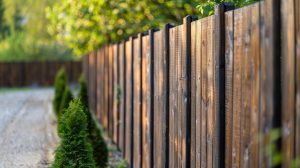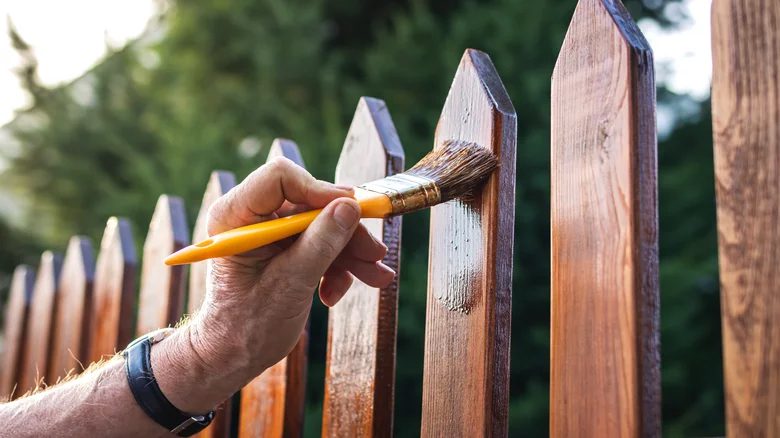


Installing a new fence? Looking to give an old fence new life? You’ve come to the right place. This article will give you the facts on the two most common methods of finishing a fence. Find out what option is best for you.
To stain or to paint – that is the question. Although you may already have a preference in mind for one or the other, it’s important to do your research. There are key factors to consider, such as longevity, weather, and appearance. Without further ado, let’s dive into the staining vs. painting debate.
You could opt to leave your fence unfinished. Some homeowners prefer the natural beauty of a wood fence. However, this will leave your wood exposed to weather conditions. For starters, rain can harm a variety of woods (even water-resistant varieties like cedar and redwood).
Our humid Georgian summers can take their toll on a wood fence, causing expansion. UV radiation can damage the strength of wood and make it more likely to crack once it dries out. Some wood types commonly used in fencing could also attract pests and wildlife.
You don’t want powder-post beetles, carpenter bees, and termites. These pests can easily be attracted to your home. This can cause further damage down the line. Fortunately, all of these problems can be eliminated by finishing your wood with either stain or paint.
Sealing your wood fence protects it. Rotting and sun damage can be avoided by a clean finish. Finishing your fence also keeps termites, mold and mildew away. Plus, the right finish will keep your fence looking amazing for years to come.
When it comes to the wood staining vs. painting debate, it’s important to weigh the pros and cons of each method. Let’s start with stains.
Wood stain is a transparent or semi-transparent finish that is often used directly on exposed wood. It colors wood by sinking deep into the wood grain. Its transparency means that it allows the wood grain to appear through the finish, giving the finish a more organic look.
Unlike paint, which mainly sits on top of the wood, the binding agent of wood stain stays below the surface, while the pigment gives the wood its distinctive color. Wood stains come in many styles and colors.
For many fences, stain is the clear winner. Stain is easier to apply than paint. It has a strong lifespan of up to 3 years. Plus, stain fades over time in a way that many people find more pleasing than paint, which tends to chip, bubble, and peel.
Many homeowners also like being able to see the natural wood grain through the finish, which is not possible when using paint.
After giving your new fence 10-12 weeks to cure, it will be ready to stain. Older fences may need light pressure washing prior to staining.
In terms of cons, there can be less variety in color. Factor this in if you want your fence to really pop with a unique color. The stain will not sink in very deeply on treated wood. Fences exposed to strong, bad weather may need more frequent coats in order to maintain the same level of quality.
Stains can also take a bit more time to dry than paint. You’ll need to wait for a period of up to two days of good weather before applying.
Moving through the painting vs staining wood discussion, we come to painting. You can use latex or oil-based paints for fencing.
However, most use latex. Latex paint can stretch. It won’t crack as easily. Paint is a complete finish that fully seals off the wood, giving it a smooth appearance.
Like stain, paint provides all the protection of a strong wood finish. Plus, it lasts up to seven years. One of the biggest reasons homeowners prefer paint over staining is the classic look of a white fence. However, paint also comes in a variety of colors if you are feeling bolder.
Now for the cons. Paint does remove the appearance of wood grain. This is a con to many homeowners. When you paint a fence, it is primarily sitting on the surface of the wood. This is why peeling and bubbling occur over time on a painted fence.
This is why surface preparation is a big deal when painting a fence. You need to make sure the fence is completely clean (usually through power washing). Scraping any old paint off is a must. You’ll also need to sand down the wood grain to ensure a smooth finish. On a large fence, this can be a lot of work. Plus, you’ll need to apply one or more coats of primer before even starting the painting process. This is important for longevity. Finally, the paint can be applied. As you can see, there is a great deal of setup required.


Ultimately, both paint and stain will help your fence resist bad weather. Over time, very negative weather conditions will wear down any wood finish. For stains, this process can lead to fading of the color.
Essentially, heavy rain, wind, and sun over the years will turn your fence from a mahogany red to a pale red or reddish-gray look. Paint is a different ball game. As the paint is impacted by weather, it tends to peel, bubble, and crack. Over time, wind and weather conditions scrape away even just a small portion of paint, allowing moisture to enter the wood.
This moisture then expands. Basically, it causes the paint to separate from the surface of the wood. This can lead to an unsightly appearance for any fence. When that happens, it’s time to scrape away the paint, sand down the wood, and re-paint or stain the wood.
When it comes to staining wood vs. painting it, you may also be curious about maintenance. Staining wood can be done using a simple sprayer. You’ll need to re-apply stains more often if your fence is exposed to more direct sunlight. Maintenance is simple. It consists of regular cleaning with a power washer and checking for damage.
If bad weather occurs, it’s important to check for damage and ensure your fence is quickly repaired to keep it in optimal condition. Be aware of excessive vegetation around the base of your fence. Cut down those overgrown shrubs. For painted fences, you will not be reapplying paint as frequently. When you do reapply paint, be sure to do all the preparation necessary to ensure a quality finish.
Click Here to Schedule a Free Consultation Or Call Us at 770-422-9996
*This credit card is issued with approved credit by Wells Fargo Bank, N.A.
Copyright © 2024 First Fence of Georgia. All Rights Reserved | Privacy Policy | Sitemap
Website designed and developed by Synergetic Media